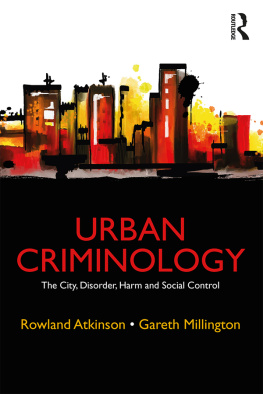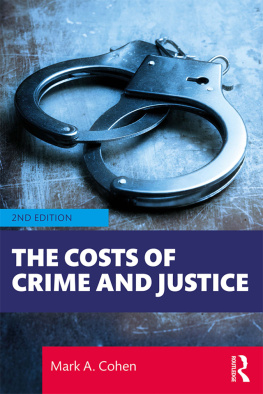FEAR of CRIME
New Observations
Howard S. Becker , series editor
The close and detailed observation of social life provides a kind of knowledge that is indispensable to our understanding of society. In the spirit of Robert E. Park, the books in this series draw on an intimate acquaintance with their subjects to make important contributions to the development of sociological theory. They dig beneath the surface of conventional pieties to get at the real story, and thus produce ideas that take account of the realities of social life.
Fear of Crime
Incivility and the Production of a Social Problem
Dan A. Lewis
Greta W. Salem
With a new introduction by the authors
First published 1986 by Transaction Publishers
Published 2017 by Routledge
2 Park Square, Milton Park, Abingdon, Oxon OX14 4RN
711 Third Avenue, New York, NY 10017, USA
Routledge is an imprint of the Taylor & Francis Group, an informa business
Copyright 1986 by Taylor & Francis.
All rights reserved. No part of this book may be reprinted or reproduced or utilised in any form or by any electronic, mechanical, or other means, now known or hereafter invented, including photocopying and recording, or in any information storage or retrieval system, without permission in writing from the publishers.
Notice:
Product or corporate names may be trademarks or registered trademarks, and are used only for identification and explanation without intent to infringe.
Library of Congress Catalog Number: 85-31827
Library of Congress Cataloging in Publication Data
Lewis, Dan A.
Fear of crime.
Bibliography: p.
Includes index.
1. Crime and criminalsUnited StatesPublic opinion. 2. Public
opinionUnited States. 3. fear. 4. Social control. I. Salem. Greta.
II. Title.
HV6791.L47 1986 364.'973 85-31827
ISBN 0-88738-086-7
ISBN 13: 978-1-4128-6310-0 (pbk)
ISBN 13: 978-0-88738-086-0 (hbk)
This book is a product of the Reactions to Crime Project (197580) conducted at the Center for Urban Affairs at Northwestern University between 1975 and 1980. Much of the data reported here were collected during those years, and our approach was shaped by the people we collaborated with during that time. We are especially appreciative of the assistance received from Ron Szoc and Mike Maxfield who did much of the statistical analyses reported in the pages to follow. Judy Lieberman was very helpful in the analysis of the qualitative data. The project was supported by the National Institute of Justice as part of their Research Agreements Program. Richard Barnes and Winifred Reed acted as liaisons between the project and the funding agency and were instrumental in the success of the project. Their support and understanding were of great value to us. Louis Masotti and Margaret Gordon served as directors of the Center during this period, and their encouragement made our work easier. There was a group of researchers at the Center that collaborated in ways not often found in the academy. In particular, Fred DuBow and Wes Skogan brought their intelligence and general good will to the cooperative efforts that led to the successful completion of the project and ultimately to this book. There were many others who worked on this project and assisted us on this book. Howard Becker, Al Hunter, Wally Goldfrank, and Paul Lavrakas gave needed encouragement and criticism that strengthened the effort. Indeed, the book has emerged over the past ten years as a dialogue with those who have been working in this field.
We wish to acknowledge the love and support of our spouses, Dick and Stephanie, and our children, Susanne, Peter, Erica, and Matthew for their general interest and help. Erica also contributed her expert editorial advice. Special thanks go to the people in the ten communities we studied, for without their openness and good will this project would not have been possible. We hope that our efforts are useful to them.
Finally, while we gratefully acknowledge the assistance of those who strengthened the book, we alone are responsible for its flaws.
This work was partially supported under Grant Number 78-NI-AX-0057 from the National Institute of Justice, U.S. Department of Justice. The survey reported upon in this volume was supported in part by Grant Number R01MH29629-01 from the National Institute of Mental Health to the Center for Urban Affairs. Points of view or opinions in this document are those of the authors and do not necessarily represent the official position or policies of the U.S. Department of Justice.
The study of social problems is always complicated by definitions What is a social problem? Who decides? How do you know its there? Is there an objective standard that can be applied to all situations or are social problems defined comparatively? There is even disagreement as to how important these questions are to the study of social problems. Some scholars see these questions as essential and problematic while others see them as marginal and routine. The importance of these definitional issues hinges on ones view of the social world. If that world is seen as a given , a reality out there in which we all participate, the problems associated with inter-subjectivity , the capacity to understand and judge the experiences of others, are seen as unimportant. If that social world is seen as an artifice, a construction, then social problems are created by men and women and their nature is problematic.
These matters are of no small import to the study of social problems. Indeed, those who see definitional issues as central focus, on the claims various groups and interests make about social problems. Because they see the study of social problems as the examination of that claim-making process, they pay little attention to the real pain and suffering experienced by the victims of the problematic behavior under consideration. (Spector and Kitsuse, 1977.) Those who see the definitional issues as marginal, because social problems are obvious and their definition commonsensical, focus on the measurement of the problem, its prevalence and solutions. They, however, frequently fail to see the multidimensional nature of the problem which stems from the varying perspectives from which it is viewed.
Recent critiques of the former position have pointed out that the emphasis on definitions renders the behavior that is problematic to a secondary status. What counts is how that behavior is defined, not how it is experienced. The result is an analysis that denies the experience of those who behave badly and those who must cope with that behavior. To reduce the study of social problems to the claims of interest groups is to lose the dimension of social life through which the problematic behavior is manifested. That dimension is often filled with citizens who bear the burden of our social problems, both as perpetrators and as victims.
This is not to dismiss the definitional issues. Lemert (1951) distinguishes between the problematic behavior people exhibit and the social responses to it by defining the former as primary and the latter as secondary deviation. Piven (1981) points out that most contemporary sociologists have emphasized the secondary and treated the primary deviation as of marginal interest. Outside of academic sociology, however, the emphasis in the last decade has been on the primary deviation , as if societys and the states responses are of little significance in the emergence and persistence of the problematic behavior.







